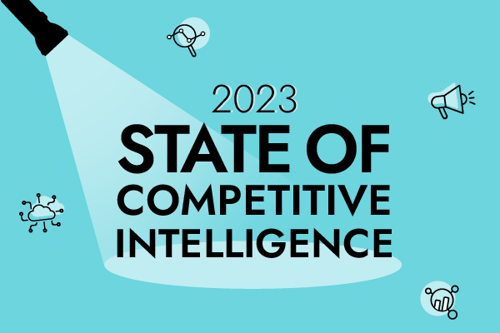Once you’ve decided to tackle win/loss analysis as an organization, the next natural step is to invest some time and thought into how you will go about collecting the data. Win/loss interviews – whether they’re run internally or by expert agencies – are fantastic resources for in-depth understanding of buying decisions. The natural partner for this qualitative information is consistent internal win/loss quantitative data from across your sales team.
But what data should you be collecting in your Customer Relationship Management (CRM) solution? And when should salespeople be asked to fill them out? Below, I detail some of the fields that you will want to ensure you have in your CRM, as well as some accompanying choices and considerations.
Get your free ebook + template: The 3 H's of a Successful Win Loss Project.
Table Stakes: The Opportunity Stage Field
Since the stage of an opportunity is so important for accurate pipeline measurement, the existence of this field is near standard across CRMs. At the very minimum, you will need a distinction between Open, Closed Won, and Closed Lost deals in this Opportunity Stage field.
Most organizations will have more than one type of Open opportunity, which can be very helpful in understanding at what point in the sales cycle losses to competitors are occurring. For example, losses in early stages generally suggest the response lies in better qualifying, whereas late-stage losses might drive more tactical needs.
Going Head-to-Head: The Opportunity Competitor Field
While a bit of a no-brainer, it is surprising how many companies aren’t collecting data on which competitors come up in a deal. Of course, lacking any tracking of specific competitors in deals means that you can only perform the broadest analysis of the deals you lost or won. It will be more difficult to distinguish deals that are lost for non-competitive reasons, and your win rates and win/loss ratios will lose significant fidelity.
There are two primary approaches to field design:
-
Single field, multi-picklist: The majority choose this approach, in which the rep chooses all competitors in a deal. The advantage of this field is that it is easier to fill out, increasing the chances that reps will provide accurate data back to you.
-
Primary and secondary fields: Some organizations with mature markets or advanced sales processes choose to use a single picklist for the primary competitor in a deal and a multi-picklist for all other competitors. The advantage of this approach is that you can obtain a more exact understanding of head-to-head competitive scenarios. One of the assumptions of this approach is that your business is a “primary” competitor itself in the opportunity; otherwise, measurement becomes very complex.
After choosing one of the approaches for storing the data, you should focus some attention on how to fill this empty field. It's important to get the most accurate data you can, considering that some prospects may not be open to discussing the other competitors in a deal with your sales rep. There is also the challenge of forgotten information if you wait too long to ask reps. You should review this implementation with sales leadership to map it to the sales process; in an ideal world, Opportunity Competitor fields would be a required field at the earliest possible stage in the sales process.
Getting to the Point: The Loss Reason Field
Loss Reasons tend to be present in most CRMs by default, and most also have something like a “Lost to Competitor” option in the single picklist. While painful for reps to input, this field is central to your effort to determine competitive losses, calculate win/loss rates, and understand head-to-head competitive data, so you should ensure that the Loss Reasons field is required.
It is unfortunately common that these reasons are often not customized to your business and market to surface actionable information. Generic options like “bad fit” or “lack of functionality” tend to obscure understanding and demand that you to speak with the sales rep to gain clarity. Why not discuss the type of bad fit that salespeople are encountering and embed those in your standard loss reasons? More refined “bad fit” loss reasons can help you tackle problems across the organization: Sales leadership can improve account targeting and territory segmentation, Product can learn about new capabilities and user needs, and Marketing can refine buyer personas and related messaging/positioning.
The Sad Truth: The Competitor Lost To Field
This field is overlooked in a surprising number of organizations. Whatever its name, the Competitor Lost To field is usually a single picklist, and the results help you measure your win rate against a specific competitor. You might consider more flexible inputs if you face competition from two or more partners combining their offerings, or if you want to distinguish between different products offered by the same competitor; in these circumstances, a second linked field will provide additional detail.
Of course, many prospects are reluctant to tell their sales reps what company was ultimately selected, so it’s valuable to include an “other” or “unknown” option that can be updated if you ever do learn the winner. You may never have perfect information, but you are likely to have a strong enough sample to drive strategic insight. Over time, your data can and probably will evolve, so it’s helpful to have the mindset that any reporting will be more of a running total than a final product.
Getting Granular: The Competitor Loss Reason Field
While the Competitor Lost To is valuable from a statistical point of view, developing a response plan to losses will require more information. Thus the addition of a Competitor Loss Reason can capture whatever repeat reasons you hear from the field. Items like Price and Functionality are common choices to include in a picklist; however, you might find a free-text field more useful since losses are rarely just about the cost or capabilities of your offerings. Like the Opportunity Loss Reason above, the more you can make these reasons reflect what your salespeople experience repeatedly, the more concrete your data set and potential learnings will be.
Any complex human-driven process is bound to have some amount of subjectivity that can color the measurement. Add in the challenge of motivating a sales team to provide clean, reliable data for which they are neither compensated nor certain about themselves, and any win/loss projects are not simple. Your job then comes down to removing as much obscurity from the picture as you can. Each ray of light that you can shine on wins and losses has the potential to pay back your efforts many times over.

Related Blog Posts
Popular Posts
-
 How to Create a Competitive Matrix (Step-by-Step Guide With Examples + Free Templates)
How to Create a Competitive Matrix (Step-by-Step Guide With Examples + Free Templates)
-
 The 8 Free Market Research Tools and Resources You Need to Know
The 8 Free Market Research Tools and Resources You Need to Know
-
 Sales Battlecards 101: How to Help Your Sellers Leave the Competition In the Dust
Sales Battlecards 101: How to Help Your Sellers Leave the Competition In the Dust
-
 6 Competitive Advantage Examples From the Real World
6 Competitive Advantage Examples From the Real World
-
 How to Measure Product Launch Success: 12 KPIs You Should Be Tracking
How to Measure Product Launch Success: 12 KPIs You Should Be Tracking




